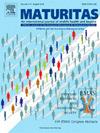一组黑人妇女的夜班工作和抗勒勒菌激素浓度
IF 3.9
2区 医学
Q2 GERIATRICS & GERONTOLOGY
引用次数: 0
摘要
目的评价当前夜班工作是否与抗本文章由计算机程序翻译,如有差异,请以英文原文为准。
Night shift work and anti-Müllerian hormone concentrations in a cohort of black women
Objectives
To evaluate if current night shift work is associated with anti-Müllerian hormone (AMH) concentrations.
Study design
We analyzed baseline data from participants in the Study of the Environment, Lifestyle, and Fibroids (SELF), a prospective cohort study of Black women recruited 2010–2012 in metropolitan Detroit, MI. Our cohort comprised 1641 participants with serum AMH determined at baseline. AMH concentrations were used to measure ovarian reserve, i.e. the quantity of oocytes remaining in the ovary. On self-administered baseline questionnaires, participants reported whether they currently worked night shifts and, if so, how frequently. We used multivariable linear regression models to estimate percent differences and 95 % confidence intervals (CI) in mean AMH concentrations across categories of current night shift work (non-current, <1/month, ≥1/month), adjusting for covariates known to be associated with AMH concentrations (e.g., demographic factors such as age, abnormal bleeding, and contraceptive use) and baseline sleep characteristics (sleep duration, satisfaction, and efficiency).
Main outcome measure
Mean anti-Müllerian hormone concentrations.
Results
Mean AMH concentrations were similar in the group of frequent night shift workers (n = 196, 12 %) and the group of infrequent/non-current night shift workers (n = 1445, 88 %): 4.78 ± 4.15 ng/mL vs. 5.14 ± 4.20 ng/mL. Results were similar after adjusting for potential confounders, with only a small percent difference in AMH concentrations of −8.1 % observed between the two groups (95 % CI -19.8 %, 5.4 %).
Conclusions
Frequent night shift work was not appreciably associated with AMH concentrations in this large cohort of reproductive-aged Black women.
求助全文
通过发布文献求助,成功后即可免费获取论文全文。
去求助
来源期刊

Maturitas
医学-妇产科学
CiteScore
9.10
自引率
2.00%
发文量
142
审稿时长
40 days
期刊介绍:
Maturitas is an international multidisciplinary peer reviewed scientific journal of midlife health and beyond publishing original research, reviews, consensus statements and guidelines, and mini-reviews. The journal provides a forum for all aspects of postreproductive health in both genders ranging from basic science to health and social care.
Topic areas include:• Aging• Alternative and Complementary medicines• Arthritis and Bone Health• Cancer• Cardiovascular Health• Cognitive and Physical Functioning• Epidemiology, health and social care• Gynecology/ Reproductive Endocrinology• Nutrition/ Obesity Diabetes/ Metabolic Syndrome• Menopause, Ovarian Aging• Mental Health• Pharmacology• Sexuality• Quality of Life
 求助内容:
求助内容: 应助结果提醒方式:
应助结果提醒方式:


